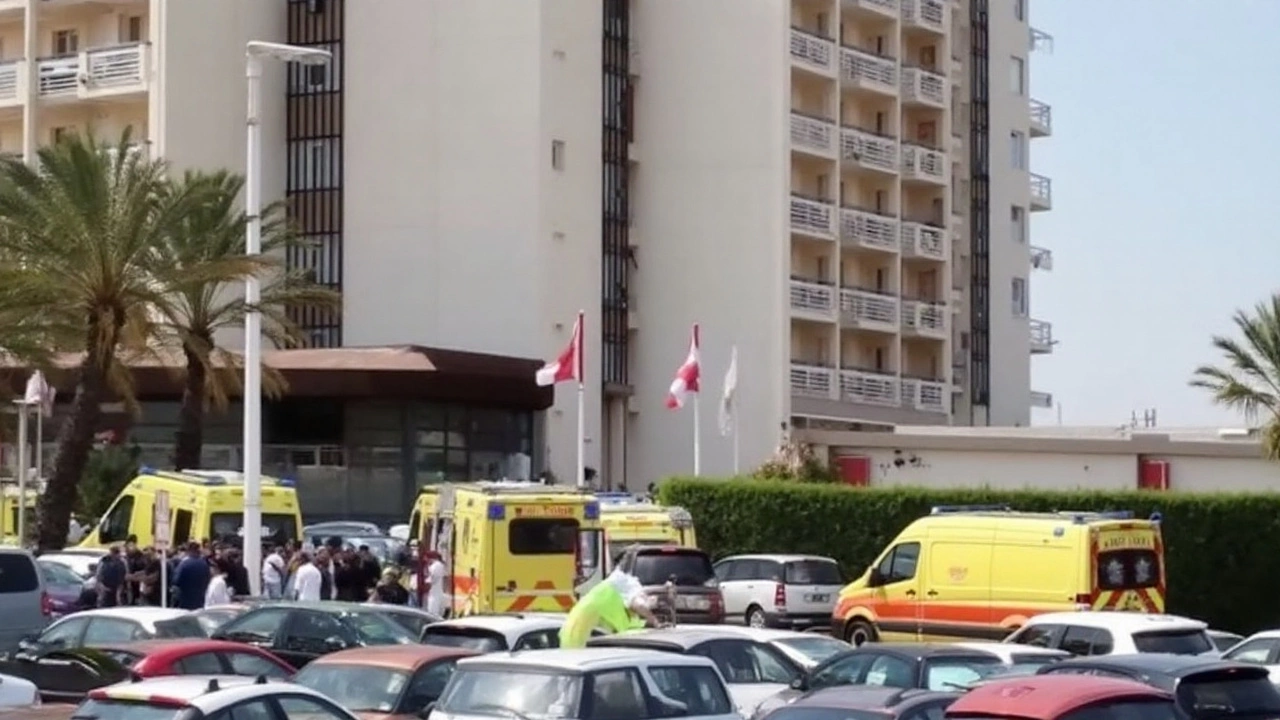What happened inside the Cavanna Hotel
Lunch ended, and the sickness began. On Saturday, August 23, 2025, a wave of gastrointestinal illness ripped through the Cavanna Hotel in La Manga, Spain. Health officials have now confirmed salmonella as the cause. Within hours of the early afternoon buffet, guests started falling ill with fever, vomiting, and diarrhea. By Sunday, the tally of people affected had jumped past 100, turning a busy beachfront hotel into a place of triage.
The Cavanna, which had around 800 guests staying over the weekend, saw hallways used as treatment areas when the volume of cases spiked. Staff cleared space, set up IV drips, and repurposed beach loungers as stretchers. A function room became a field hospital. Emergency teams were called in from Cartagena, Murcia, Los Alcázares, Puerto Lumbreras, and La Manga to keep up with the pace of new patients.
Roughly 20 people needed hospital care in Cartagena, including eight children. The youngest serious case was a 15‑month‑old sent to Santa Lucía hospital for specialist treatment after developing a high fever. Most others were stabilized on site with fluids and anti-nausea support before being monitored in their rooms.
Guests pointed to buffet dishes served shortly before the first symptoms started. Several families linked the illness to a spinach-filled pasta dish. Others suspected the fish section of the buffet. In one group, the only person who ate fish ended up in bed with severe stomach cramps while the meat eaters stayed well. That split is the kind of detail investigators look for in outbreaks like this.
Regional health authorities moved fast. Inspectors took food and surface samples from the kitchen, interviewed staff, and tested food handlers. They shut the hotel’s kitchen as a precaution and ordered a deep clean of prep areas, equipment, storage, and serving lines. Until the lab results come back and hygiene controls are verified, the hotel can’t cook. Management has not issued a public statement so far.
For many families, the final weekend of the summer holiday collapsed into a blur of IV stands and disposable gloves. Parents carried sick kids through corridors instead of down to the beach. People swapped tips on oral rehydration salts instead of restaurant recommendations. That’s how fast a buffet service can turn.

Why it happened, what investigators are testing, and what comes next
The question now is how salmonella got into the food and spread to so many people. Salmonella is a hardy bacteria that thrives when food safety steps slip. It’s best known for turning up in raw or undercooked eggs and poultry, but it can ride along on many foods—fish, salad greens, sauces, or anything that touches a contaminated surface. Once it’s on a buffet, it can move quickly if hot foods aren’t kept hot, cold foods aren’t kept cold, or utensils are shared between dishes.
Investigators will try to pin down the “vehicle” dish—the specific item that carried the bacteria. The spinach pasta and the fish counter are obvious leads because multiple guests independently flagged them. That doesn’t prove either one is the source, but it gives inspectors somewhere to start. They’ll run lab tests on leftover portions (if any remain), swabs from serving trays and utensils, cutting boards, sinks, and prep tables, plus stool samples from some of the people who got sick. They’ll also test food handlers to see if anyone was shedding bacteria without realizing it.
Timing matters. Salmonella symptoms usually start 6 to 72 hours after exposure. Many guests felt sick the same day, which fits the shorter end of that window. If most cases clustered within a few hours of each other, it suggests a single contaminated dish at a single meal rather than a prolonged issue across several services.
Buffets are high-pressure operations. On a peak-season weekend, kitchen teams push out hundreds of plates in rapid cycles. Safety depends on a chain of small, boring tasks done right every time: chilling salads below 5°C, holding hot dishes above 60°C, changing pans before they run low, swapping tongs between raw and cooked foods, sanitizing boards between tasks, logging temperatures every service, and checking that deliveries arrive cold. Break one link in that chain, and bacteria can multiply fast—especially in rich, moist dishes like pasta in cream sauce or fish prepared in batches and left on warmers.
In Spain, hotels and restaurants are required to run a food safety plan based on HACCP (Hazard Analysis and Critical Control Points). That means they should have written procedures for cooking, cooling, hot holding, cold holding, cleaning, and staff hygiene. Health inspectors will ask for those records—temperature logs, cleaning schedules, supplier slips, and staff training certificates—and compare them to what they see in the kitchen. If logs are incomplete or temperatures were off, the paper trail will show it.
Cross-contamination is another likely scenario. A cutting board used for raw ingredients that then touches cooked food, a serving spoon moved from one tray to another, or a sauce container refilled without washing can spread bacteria across a buffet. Even a well-cooked dish can become contaminated again if it’s handled with the wrong utensil afterward.
Why did so many people get hit at once? Two reasons. First, a buffet means many diners eat the same dish in a short window. Second, families often share plates or try bites from each other’s food. That raises the number of exposures without anyone realizing it.
Who’s at highest risk of severe illness? Young children, older adults, pregnant people, and anyone with a weakened immune system. That lines up with what we saw at the Cavanna: eight children among the hospitalized and a 15‑month‑old needing specialized care. Most healthy adults recover in a few days, but dehydration can creep up quickly, and complications do happen.
What are the symptoms, and when should someone seek help? Typical signs include diarrhea, vomiting, stomach cramps, fever, chills, and a pounding headache from fluid loss. Medical care is vital if there’s blood in the stool, signs of dehydration (very dark urine, dizziness, dry mouth), a high or persistent fever, severe abdominal pain, or symptoms lasting more than a few days. Infants and older adults should be checked sooner rather than later.
How will authorities clear the kitchen to reopen? They’ll need negative lab results for the suspected foods or surfaces, proof that cleaning and disinfection were done correctly, and evidence that hot and cold holding can stay within safe limits during service. They may require retraining of staff and new controls, like more frequent temperature checks or smaller batch sizes for high-risk dishes. Only when those boxes are ticked will cooking resume.
Could it have been the fish? It’s possible, though fish isn’t the most common salmonella vehicle on its own. Cross-contamination from raw poultry or eggs in a shared prep area is a more typical route. A creamy pasta that includes egg-based sauces, for example, can be risky if cooked in bulk and kept warm too long. Investigators will sort that out with lab evidence and the pattern of who ate what and when.
What we don’t know yet: the exact dish, the original source of the bacteria (supplier versus on-site handling), the specific salmonella strain, and whether cases spread beyond those first 24 to 36 hours. We also don’t know how many staff, if any, were affected. Those details usually come in a follow-up bulletin from the regional health department once lab work is finished.
The Cavanna has not commented publicly. Silence in the first 48 hours isn’t unusual during an active investigation, but guests will expect answers about refunds, accountability, and what safeguards will change in the kitchen. Travel insurers may ask for medical notes or receipts for treatment. Anyone making a claim should keep documentation and report their illness to local health authorities back home, which helps track outbreaks tied to international travel.
How common is this? In Europe, salmonellosis remains one of the top reported foodborne illnesses each year, according to surveillance by the European Food Safety Authority and the European Centre for Disease Prevention and Control. Outbreaks often trace back to a single high-risk item served to many people at once—think egg-based sauces, undercooked poultry, or improperly chilled dishes at large events. Hotels with buffet service face a higher bar because volume and speed can break routines.
For travelers currently in La Manga who aren’t ill but are worried, here’s the short version of what to do next:
- Check with the hotel about meal arrangements while the kitchen is closed; many properties bring in outside catering or switch to pre-packaged options during investigations.
- Stick to freshly cooked food served piping hot; avoid items that sit lukewarm on a counter.
- Wash or sanitize hands before eating and after touching shared tongs or ladles.
- If you feel unwell, hydrate aggressively with water, broths, or oral rehydration salts; avoid alcohol and heavy foods.
If you were sick over the weekend and have since improved, consider contacting your local health service when you return home to report a suspected foodborne illness linked to travel. Reporting helps doctors spot patterns and helps public health teams link cases across borders. If symptoms are still active, seek care now—stool tests can confirm salmonella, and clinicians can check for dehydration.
For families with children, watch for reduced urine output, listlessness, or a fever that doesn’t respond to paracetamol/acetaminophen, and seek medical help sooner rather than later. Keep a simple log of onset time, foods eaten, and any medication given; doctors find that very useful in deciding next steps.
What happens to the hotel next? After the kitchen passes inspection, the hard work is rebuilding trust. That often means visible changes: smaller batch cooking to keep foods out of the danger zone, more staff at the buffet to manage utensils and replace trays, temperature displays at serving lines, and clearer labeling so guests know what they’re eating. Behind the scenes, expect tighter supplier checks, stricter receiving temperatures, and daily staff briefings during service.
Outbreaks like this are a harsh reminder that food safety is a system, not a slogan. Every step matters, from the delivery truck temperature to the moment a guest lifts a lid on a chafing dish. On a summer Saturday with a full house and a busy buffet, that system failed at the Cavanna—and more than 100 people paid the price.
Authorities will publish their findings once the lab work and interviews are complete. Until then, the facts stand: a confirmed salmonella outbreak, a closed kitchen, dozens treated on site, and around 20 hospitalizations including eight children. For anyone spending their last days of summer in La Manga, it’s a tough lesson in how quickly a holiday can change.





